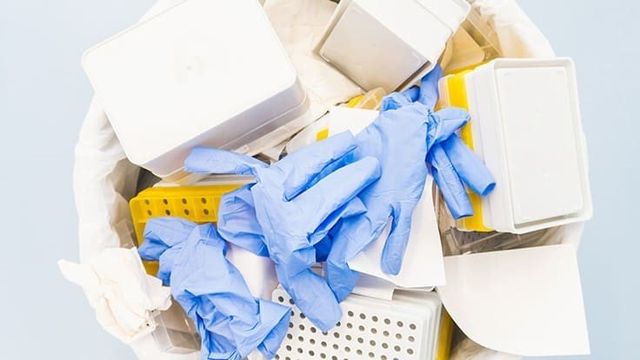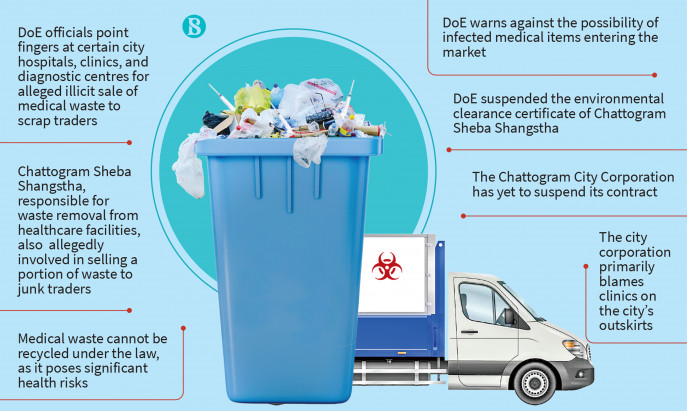Medical Waste Removal Excellence: Elevating Security Standards in Your Center
The Value of Correct Clinical Waste Disposal: An Overview for Health Care Facilities
Appropriate clinical garbage disposal is an essential facet of medical care facility monitoring, making certain the security and wellness of clients, team, and the setting. From recognizing the various categories of medical waste to abiding with governing needs, medical care centers have to embrace reliable waste partition methods and choose proper disposal techniques. The value of correct clinical waste disposal goes beyond mere conformity; it is a responsibility that needs recurring training and education and learning for team. In this guide, we will certainly explore the different elements of medical garbage disposal and highlight the essential actions that health care facilities need to take. By carrying out these techniques, healthcare centers can mitigate threats, secure public wellness, and add to a cleaner, more secure environment.
Comprehending Clinical Waste Categories
Understanding medical waste categories is crucial for correct disposal in healthcare facilities. Medical waste is a wide term that incorporates various types of waste created in healthcare settings, such as medical facilities, research laboratories, and clinics. Classifying clinical waste aids ensure that it is taken care of, kept, and disposed of securely and based on applicable regulations.
There are numerous classifications of medical waste that healthcare centers require to be conscious of. These categories consist of transmittable waste, sharps waste, pharmaceutical waste, chemical waste, and radioactive waste (medical waste disposal services with WasteX). Each category has specific features and requires different disposal methods to reduce the danger of damage to medical care employees, people, and the environment
Infectious waste, as an example, refers to waste polluted with potentially contagious materials, such as blood, body fluids, and tissues. Sharps waste consists of needles, syringes, and various other sharp things that can cause injury or transfer infections. Drug waste consists of ended or extra medicines, while chemical waste includes harmful chemicals made use of in clinical treatments. Lastly, radioactive waste includes materials contaminated with contaminated materials, such as nuclear medicine products.
Conformity With Regulatory Demands
Medical care centers have to ensure conformity with governing needs for proper medical waste disposal. Regulatory bodies, such as the Epa (EPA) and the Occupational Safety And Security and Wellness Management (OSHA), have developed regulations and guidelines to protect public health and wellness and the atmosphere. These guidelines lay out the correct handling, storage space, transportation, and disposal of clinical waste.
Conformity with regulatory requirements is crucial for medical care centers to prevent lawful fines, reputational damages, and prospective harm to human wellness and the atmosphere. Failing to adhere to these policies can cause penalties, legal actions, and even the suspension or retraction of running licenses.
To make sure compliance, health care facilities ought to develop thorough waste administration programs that include staff training, proper waste partition, and using appropriate containers and labels. Normal audits and examinations ought to likewise be performed to determine any non-compliance concerns and resolve them immediately.
It is vital for healthcare centers to remain up to date with modifications in guidelines and upgrade their waste management methods as necessary. This can be accomplished by proactively monitoring updates from regulative bodies and taking part in training programs and workshops.
Carrying Out Effective Waste Segregation Practices
To make sure appropriate medical garbage disposal, health care centers need to execute effective waste partition methods. Waste segregation is an essential action in the overall waste management procedure, as it assists lessen the danger of infection, stops cross-contamination, and makes certain the safe disposal of different sorts of waste. Efficient waste partition techniques entail dividing clinical waste into various groups based on its attributes and possible dangers.
One common technique is the segregation of sharps waste, such as needles and scalpels, from various other sorts of clinical waste. Sharps waste ought to be placed in puncture-resistant containers to stop injuries Continue and possible infections. In addition, contaminated materials, such as pharmaceuticals and chemicals, need to be divided from basic clinical waste to stop environmental contamination.
Correct labeling and color-coding of waste containers are necessary for efficient waste partition. Visible and clear labels should be positioned on each container to show the sort of waste it has and any type of special delivery needs - medical waste disposal services with WasteX. Furthermore, color-coding can be made use of to distinguish in between various waste groups, making it much easier for health care team to get rid of and determine of waste appropriately
Normal training and education and learning for healthcare team is vital for the effective application of waste segregation techniques. Personnel participants must be educated on the different waste categories, correct segregation techniques, and the value of following waste management protocols. This will certainly assist make sure compliance and consistency in waste partition techniques throughout the facility.
Choosing Appropriate Disposal Techniques
Appropriate selection of appropriate disposal methods is important in making sure the ecologically accountable and secure monitoring of medical waste in healthcare centers. Healthcare centers create a range of medical waste, including sharps, infectious waste, pharmaceutical waste, and chemical waste - medical waste removal services. Each kind of waste needs specific disposal techniques to minimize the danger of contamination, injury, and ecological injury
One common disposal approach for medical waste is incineration. Incineration involves informative post the regulated burning of waste at high temperatures.

Chemical disinfection is one more approach used for sure sorts of medical waste, such as pharmaceutical waste. This technique makes use of chemicals to reduce the effects of or damage pollutants. Nonetheless, it is necessary to choose chemicals that are safe and eco-friendly.
In some cases, land fill disposal might appropriate for non-hazardous clinical waste (medical waste disposal services with WasteX). Appropriate partition and product packaging are essential to protect against leak or contamination.
Eventually, health care centers should very carefully evaluate the qualities of their medical waste and select ideal disposal techniques that prioritize safety and security, environmental defense, and regulatory conformity. Regular training and monitoring are essential to make certain that health care staff follows correct disposal methods.

Training and Educating Team on Correct Disposal Treatments
Staff education and training play an important role in ensuring the correct disposal of medical waste in health care facilities. It is important that all personnel participants, consisting of physicians, nurses, service technicians, and support team, obtain thorough training on correct disposal treatments. This training should cover the various sorts of clinical waste, their prospective dangers, and the ideal methods for handling, setting apart, and taking care of them.
One of the main objectives of personnel education and training is to make sure that all healthcare professionals recognize the importance of correct disposal procedures and the possible effects of incorrect waste administration. They need to be conscious of the threats linked with clinical waste, such as the transmission of infections and the contamination of the atmosphere. medical waste removal services. By comprehending these risks, team member will be extra inspired to adhere to correct disposal procedures and take the necessary preventative measures to safeguard themselves, their associates, and the community
Training should additionally cover the usage of personal protective devices (PPE) and the appropriate methods for taking care of medical waste. Personnel must be educated on how to recognize and set apart different kinds of waste, such as sharps, transmittable waste, and unsafe chemicals. They need to additionally be educated on the proper use waste containers, such as sharps containers and biohazard bags, along with the relevance of labeling and securing these containers correctly.
Furthermore, personnel education and training must include normal updates and refresher course programs to guarantee that health care experts stay informed about the most up to date regulations and finest methods in clinical garbage disposal. This recurring education is critical to preserve a high degree of recognition and compliance amongst employee.
Final Thought
Finally, appropriate clinical waste disposal is of utmost value for health care centers. Understanding the various classifications of clinical waste and abiding with governing requirements makes sure the safety and well-being of both healthcare employees and the basic public. Executing reliable waste segregation practices and selecting suitable disposal approaches are critical in avoiding the spread of transmittable diseases and shielding the environment. Lastly, training and informing personnel on correct disposal procedures is necessary for keeping a risk-free and clean health care center.
From understanding the different groups of clinical waste to complying with regulatory requirements, health care centers have to take on effective waste partition practices and choose proper disposal techniques. These categories include infectious waste, sharps waste, pharmaceutical waste, chemical waste, and radioactive waste.To make sure appropriate medical waste disposal, medical care facilities should carry out reliable waste partition techniques. Waste partition is a crucial action in the general waste management procedure, as it helps minimize the threat of infection, protects against cross-contamination, and discover this info here ensures the safe disposal of various types of waste. Healthcare facilities produce a selection of medical waste, consisting of sharps, infectious waste, pharmaceutical waste, and chemical waste.